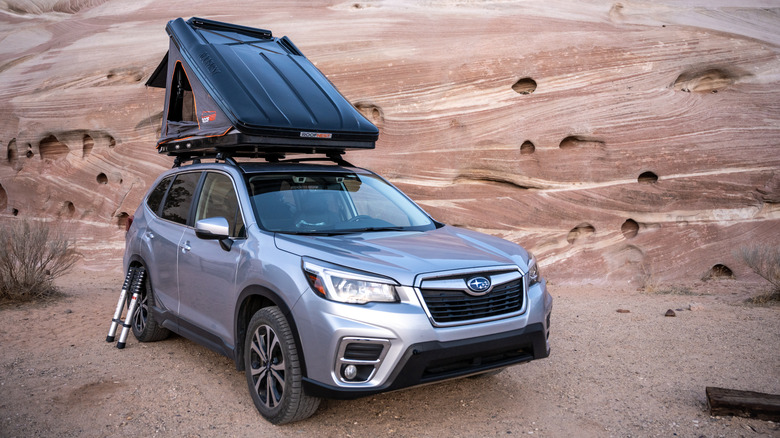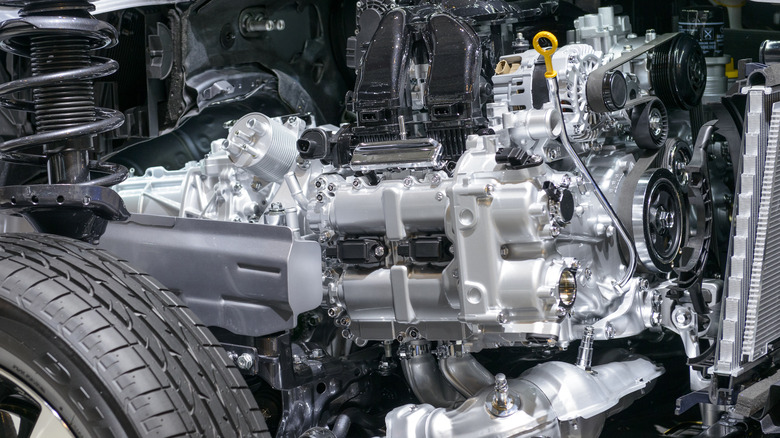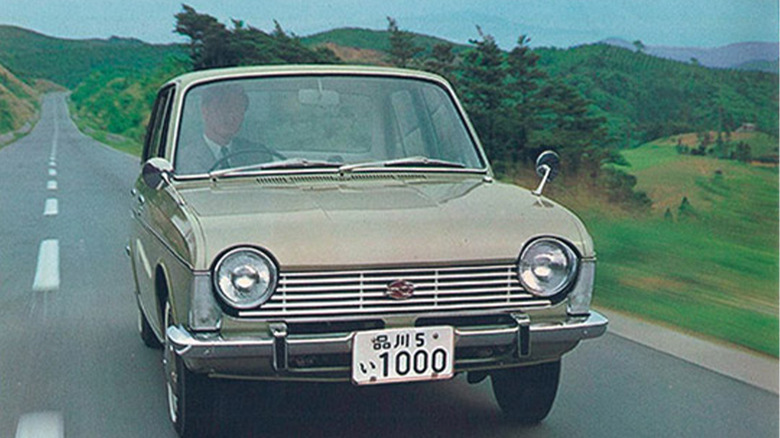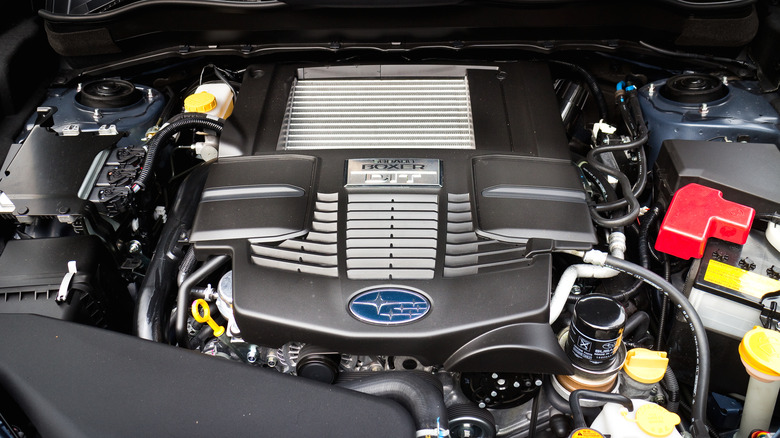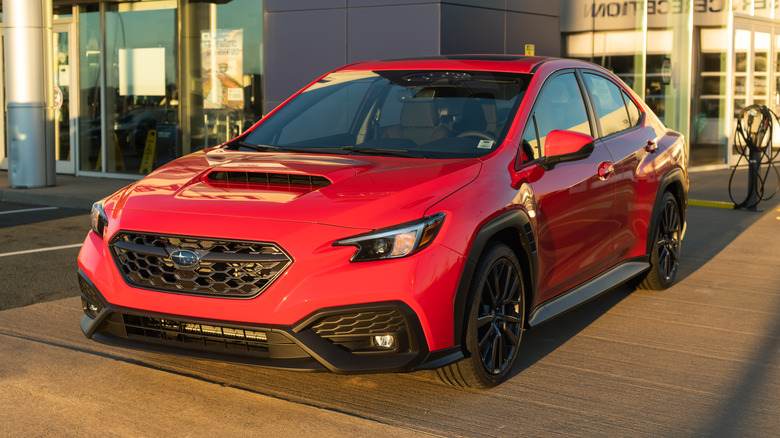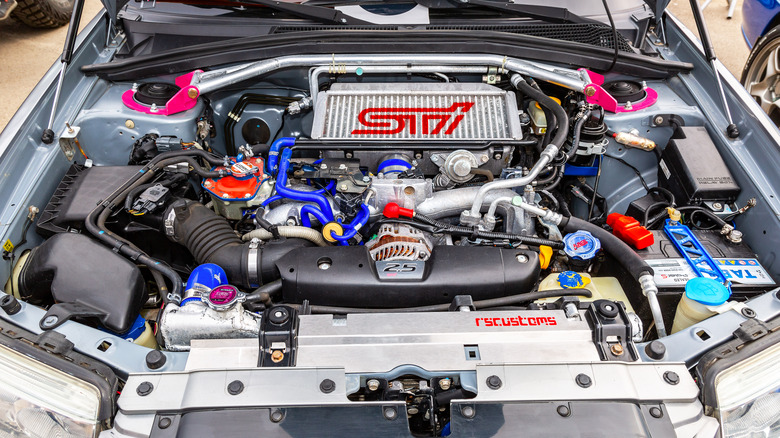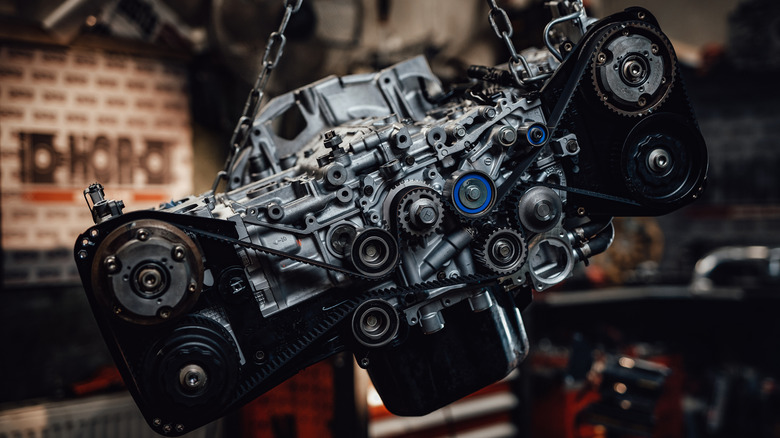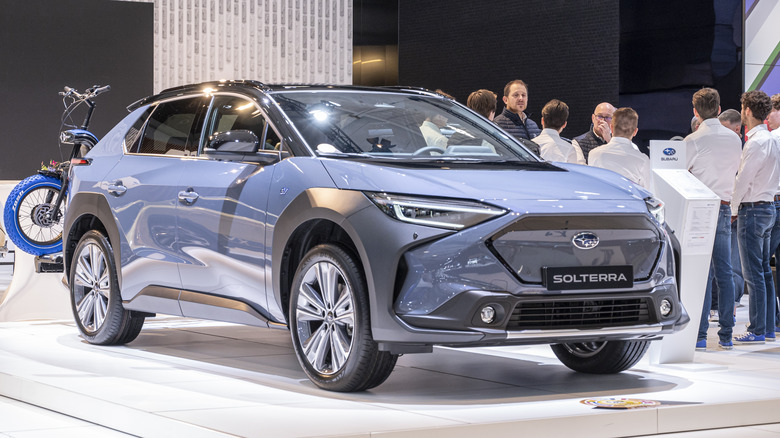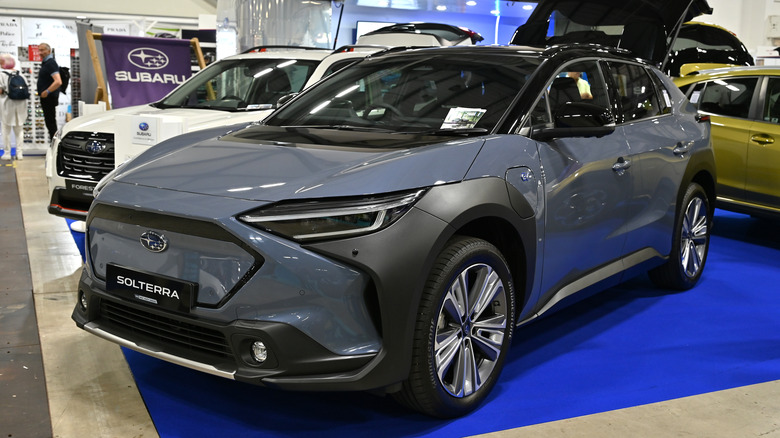History Of The Subaru Boxer Engine (And What Makes It So Unique)
Subaru is generally known for a lot of things. Almost all of its cars come with all-wheel drive as standard, something virtually no other mainstream car company does. The brand is also known for its adventurous side, with excellent off-road capabilities and vehicles built for an outdoorsy lifestyle. You'll see a lot of them in mountainous states like Colorado, Connecticut, Maine, and Washington state, where there is also a lot of snow. It's because of that excellent all-wheel drive and each Subaru's ability to get out of sticky situations.
There are other things that Subaru is known for, and among them is the boxer engine. Nearly every Subaru comes with one, and it's been that way for decades. That makes Subaru unique because most other car companies use V-style or inline engines for most of their cars for varying reasons. Thus, the boxer engine is almost synonymous with Subaru, at least when it comes to four-wheeled automobiles. The company is so married to the powerplant style that whole web pages on Subaru's website are dedicated to them.
So, that begs the question: Why is Subaru such a big fan of the boxer engine as a brand? We'll talk about that, the pros and cons of boxer engines in general, a little bit about the history of the boxer engine, and its future in Subaru's lineup, along with the first Subaru with the famed engine. We'll also talk about other examples of boxer engines, also known as flat engines, in other types of vehicles.
What is a boxer engine?
Let's start with the basics and how to tell each of the main styles of the engine apart. There are several different types of engines out in the world, and their names have to do with how the cylinders are arranged in the engine block. You're likely familiar with V-style engines, such as a V6 or a V8. In these engines, the cylinders are arranged in a V shape in the engine block. There is always a corresponding cylinder on each side, so all V-style engines have an even number of cylinders. Hence, the V4, V6, V8, V10, and V12.
Another type is the inline engine. Pistons in an inline engine are lined up in a row. Cylinders also usually fire vertically in an inline engine, making them longer than V-style and boxer engines. Inline engines don't have the same limitations as V-style engines, so you can have an odd number of cylinders in an inline engine. Much like the V6 or V4 monikers, inline engines are often called straight engines, and you'll see them referred to as a straight six if there are six cylinders or a straight four if there are four cylinders.
Boxer engines, also known as flat engines, have the cylinders laying side-by-side in a horizontal arrangement. This makes them much flatter than V or inline engines but also wider. Imagine a V engine, but if the cylinders were flat instead of in a V-shape. As such, boxers always have an even number of cylinders as well. The nomenclature for boxer engines is just the word flat, so a four-cylinder boxer engine is often referred to as a flat four.
Early history of the boxer engine
Mercedes-Benz claims that it had the first boxer engine. It was invented by Karl Benz all the way back in 1897. It was known as the kontra engine back then. Kontra is German for "against," and that's a good descriptor of a boxer engine. The first was a flat-two that debuted in the 1899 Mercedes-Benz Dos-à-Dos. However, Mercedes eventually migrated to inline engines. Eventually, the boxer reappeared in the Volkswagen Beetle in the 1930s and '40s. That's when it started to get more traction.
Porche started using the boxer engine in 1948 with the flat-four in the Porsche 356. While it too eventually moved on to use other types of engines, Porsche is one of the few manufacturers that still uses boxers today in the Porsche 718 Boxster, 718 Cayman, and the 718 Spyder. Some other OEMs used the boxer engine on and off over the years, but Mercedes, Volkswagen, and Porsche were the biggest early adopters of the engine type.
Subaru joined the party in 1966 with the Subaru 1000, also known as the Subaru FF1. Over time, the automaker started using the boxer in more and more models until it became the primary engine type in all of Subarus today. There have been ups and downs that come with it. For example, it was rumored several years ago that the WRX would stop using the boxer engine due to emissions regulations. Of course, that ended up just being a rumor, as the WRX still uses the Subaru Boxer engine as of 2023.
What makes Subaru engines special?
What makes Subaru special is that it's the only mainstream brand to use a boxer engine. Thus, they are the only mainstream cars on the market that have the engine characteristics specific to a boxer engine. Subaru is quite proud of this relationship it has with the unique engine type, as all other mainstream automakers use inline or V-style engines. Simply being the only OEM to use a boxer engine makes Subarus feel different than any other mainstream vehicle. The unique characteristics also give Subarus a different engine feel than most competitors.
Subaru has also worked hard to integrate other systems into its boxer engine setup. For example, the symmetric all-wheel drive and CVT transmissions that come with most Subaru vehicles are heavily integrated into the boxer engine. Thus, it's not uncommon to see Subaru market all three components together. That, combined with being the only OEM to use boxers in all of its cars, is what, as the advertisements say, makes a Subaru a Subaru.
It's just not just marketing, either. Consumer Reports routinely puts Subaru in the top 10 when it comes to reliability as well. The boxer engine works, and it works well. Subaru puts them in every car, so matter which one you buy, it always feels like a Subaru. That's a unique distinction, especially in a market where manufacturers can use many different types of engines and transmissions together. Most other automakers don't have a signature feel to their drivetrains. Subaru does, and it has been banking on it for years.
Why Subaru still uses boxer engines
Subaru still uses the boxer engine because the company likes the benefits. In fact, Subaru likes the boxer engine so much that most dealership websites have at least one webpage dedicated to the boxer engine. When your company culture is that ingrained with a product, it makes sense that the company continues to use that product, and Subaru's boxer engines are no exception. It's not just an identity thing, though. There are actual benefits to using a boxer engine over an inline or a V engine.
Given the boxer's cylinder setup, they tend to vibrate less than other types of engines. The science is long with many large words. However, the premise is that the flat, symmetrical cylinders cancel each other out and result in less vibration across the entire rev range. Subaru also boasts more fluid power delivery, which the company accentuates with its AWD and CVT transmission. Subaru's enhancements and improvements over the years have only made those advantages clearer.
Finally, the engine is flatter than other engine types, which means it sits lower in the car's chassis. Engines are heavy, so that does affect the balance of the car by lowering its center of gravity, resulting in more responsiveness. The larger surface area also makes the boxer engine easier to cool, provided the manufacturer does its cooling correctly. As you can imagine, Subaru is on the list of automakers that do it correctly. As we mentioned earlier, all of these things give Subaru its distinctive feel, which is why Subaru keeps using these engines.
Safety and reliability matter too
We've gone over the basic pros of a boxer engine, but some extras help, too. Subaru maintains that boxer engines are reliable and safe, and that's part of the brand's image. Subaru says that the boxer engine's lower center of gravity and symmetrically balanced design help make for a more balanced overall car, which helps drivers keep control of their vehicles in more situations. It's not a massive difference from inline or V engines, but it's enough that Subaru markets it as such consistently.
Some other safety features, both intentional and unintentional, exist with the boxer engine. For example, because it's not a tall engine and usually sits toward the bottom of the engine bay, it's more likely to get pushed under the passenger compartment if the car hits something head-on. That has the potential to prevent injuries. There are several other minor things like this, but it's all about the sum of its parts. These engines have the potential to be much safer, even if the exact metrics are difficult to find.
Reliability is also a high point for Subaru. Consumer Reports puts it toward the top of its reliability lists. JD Power does as well, with Subaru ranking number one on its consumer loyalty survey. The brand also consistently receives JD Power awards for reliability and dependability. It doesn't top a lot of lists in terms of pure reliability, and it also has recalls like every other automaker. However, it's less often than most that you'll see a Subaru with tons and tons of issues.
Cons of a boxer engine
We've been talking up Subaru and its boxer engines for this entire article so far, but like all things in life, there are pros and cons to everything. The boxer engine is no exception. In addition, engineering has mitigated a lot of the downsides of other engines to put them more or less in line with boxer engines. For example, inline engines often use balance shafts to cancel out vibrations. Yes, it's an extra piece of equipment on an already complex car engine, but it does work to cancel out vibrations, making both types of engines relatively smooth.
Another detriment is the size proportions. Boxer engines tend to be wide and flat, which can make them difficult to integrate into a car's chassis without special considerations. Subaru makes these considerations without making its cars super wide, but most Subarus have four-cylinder engines. Six- and eight-cylinder boxers are much less common because they are pretty large overall. Subaru has only made a few six-cylinder engines in its history, and size may be one of the reasons why.
Perhaps the biggest flaw with boxer engines is repairability. Inline engines share a single-cylinder head, which rests on top of the engine and makes them fairly easy engines to service. Boxers have cylinder heads on the sides of the engine, which can make some maintenance and repairs more difficult. It's not uncommon to see folks complain about manually changing the spark plugs or repairing the head gaskets on a Subaru engine.
Even the hybrids use boxer engines
You would think with the move to electrification, Subaru would start considering leaving the boxer behind. You would be mistaken. Even hybrid Subaru models use boxer engines, albeit a slightly different variant. Subaru has actually worked quite hard to integrate electric drivetrain components around its existing boxer engine, resulting in the company's e-BOXER range of vehicles. These cars have a boxer engine as the internal combustion engine with an electric motor and battery packs integrated for better fuel efficiency.
Some examples of this technology in the real world include the hybrid versions of the Subaru Forester, Impreza, and Crosstrek. In most cases, the company combines its 2.0-liter boxer engine with the additional hybrid powertrains. The boost to fuel economy is pretty good, and the plug-in hybrids can usually do just shy of 20 miles strictly on electric. Subaru is bringing more electrified cars to the market in the coming years. For the hybrids, at least, we should see the boxer engine continue to be part of Subaru's lineup.
It's honestly a creative way to keep the tradition alive. Subarus tend to enjoy pretty decent fuel economy, even for gas engines. The 2022 Subaru Crosstrek, for instance, gets 33 MPG on the highway and 28 MPG in the city if equipped with a symmetrical AWD and the CVT. The plug-in hybrid version of the 2023 Subaru Crosstrek gets 90 MPGe on the battery alone and 35 MPG combined with the gas engine. Modern Subarus found a way to keep the boxer while bringing hybrids into the mix. It's genius from a marketing perspective.
The future of the boxer engine at Subaru
The boxer engine is sure to be in any Subaru with an internal combustion engine moving forward. However, EVs are definitely the future, and Subaru is working on those just like everybody else. Right now, Subaru has the Solterra, an EV SUV that it developed with Toyota along with Toyota's bZ4x. As such, the EV doesn't have the boxer engine of the previous Subaru for obvious reasons. Electric motors don't use cylinders, so there's no need to give such an engine a boxer-like shape or appearance. However, Subaru does boast its symmetric AWD system with EVs, so at least some of the old Subaru stuff is making its way into newer vehicles.
For hybrids, we already talked about Subaru's creative e-BOXER engine. According to the company, it's basically the same old flat-four that Subaru uses in everything, but with the added fuel and power benefits of a hybrid drivetrain crafted into it. It's a stop-gap measure between ICE and EV vehicles, but hybrids should remain relevant for years to come.
Thus, the boxer engine's days are numbered if we ever move to an automotive industry where EVs are all we can choose from. There are myriad emissions laws, especially in the EU, that are making it more difficult for automakers to keep ICE vehicles on the road. Many manufacturers have already retired their eight and six-cylinder engines in favor of turbocharged four-cylinder engines to help meet emissions quotas. So far, the boxer engine remains unaffected, but as we talked about earlier, the rumors of Subaru giving up the boxer engine for more emission-friendly engine types are almost always around.
Other examples of the boxer engine
So, we've discussed Subaru and its boxer engines at length, but what about other manufacturers? Porsche uses them in a few cars, and that's really all you can find in modern automobiles. However, other automakers have used them in the past. Some examples include the Alfa Romeo Aflasud, Lancia Flavia, Toyota Publica, Citroen 2CV, and the Chevy Corvair. These were all experimental cars in their day, and their various makers didn't opt to continue using the boxer engine. It makes sense, though, since other engines have their pros and cons and well, and those pros better suited the kinds of cars those automakers wanted to make.
Where the flat engine really lives, though, is in motorcycles. It's one of the most popular motorcycle engine types, and you can find plenty of modern examples of flat engines there. Honda equips several of its motorcycles with flat-four and flat-six engines, including the GL 1500 and the GL 1800. BMW also uses it in its R-series of motorcycles. Like cars, there are more examples throughout history, but BMW and Honda carry the torch today.
There are other examples in other industries as well. Some of the oldest airplanes used flat engines, including the Pearse monoplane from 1902. However, examples outside of automobiles and motorcycles are rather rare and difficult to find. In any case, the boxer engine always seems to be hiding in the shadows of history books. The Volkswagen Beetle is an iconic car and has been for nearly a century, but most folks simply don't think about boxer engines when they think about Beetles.
